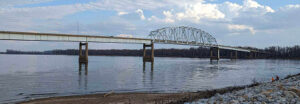North Carolina sees all types of flooding. To the west, mountain communities face flash floods and landslides. To the east, coastal communities face sea level rise, storm surge, and beach erosion.
All the while, the flow of floodwaters are determined by watersheds, which ignore jurisdictional boundaries and span multiple communities.
With such a destructive and widespread challenge, North Carolina needs a comprehensive, statewide, and watershed-based strategy to protect themselves against flooding and sea level rise. The state laid the foundation of this strategy in 2021, when the North Carolina Legislature dedicated $20 million to create the Flood Resiliency Blueprint.
As North Carolina’s first comprehensive statewide vision on flooding, the Blueprint offers communities guidance on how to make decisions and drive investments by helping them identify and prioritize projects in the most flood-prone communities.
The legislature has since committed hundreds of millions of dollars in long-term funds to prepare for, reduce the risk of, and recover from devastating flooding.
Why a watershed-based approach to flooding?
How floodwaters flow is determined by watersheds — not jurisdictional boundaries between municipalities. So flood planning should be coordinated at the watershed level. And state governments are best positioned to do this.
That’s why North Carolina’s Blueprint pilots a watershed-level approach to flood modeling and planning. This approach also reduces inequities because it provides support even to those communities that are most at risk or that lack resources to tackle the problem on their own.
Through the Blueprint, North Carolina joins several other states that are leading on watershed-scale and regional approaches to flooding. In Texas, the Texas Water Development Board established 15 regional flood planning groups based on major river basins. These groups developed the state’s first regional flood plans, which will culminate in a statewide flood plan.
And in Florida, five water management districts cover the whole state to preserve and protect water supply, resources, and natural systems. On top of managing water quality, the districts protect public safety by implementing flood projects, as well as supporting local communities that carry out their own flood projects.
Other states can explore and reference these approaches when determining how to manage flood risk in their own regions. For more, states can visit the website of the AFC-convened State Resilience Partnership — a network of organizations, convened by the American Flood Coalition, that advances resilience initiatives, develops research, and curates best practices.
AFC pushes for and guides the Blueprint

Currently, most communities lack sufficient data about flood risk to make informed decisions on projects to protect against flooding or sea level rise. They also have little way of knowing if a project built in one area could inadvertently harm a downstream community.
The Blueprint changes all that. In 2021, seeing the need for a coordinated flood resilience strategy in North Carolina, AFC pushed for the creation of a blueprint. When the General Assembly dedicated millions to create the Blueprint, it tasked North Carolina’s Department of Environmental Quality to develop it.
Since then, representatives from the AFC have served on several advisory groups led by DEQ, including the Principal Advisory Group. In our role, we’ve worked to ensure that the Blueprint is backed by accurate data and consistent methodology. We’ve also brought together and increased awareness of the Blueprint among local leaders, ensuring that their needs are reflected in the development of the Blueprint.
We draw much of our guidance from the voices of our 400+ coalition members, including 90 mayors, country commissioners, councils of governments, and other representatives in North Carolina.
What’s next
As the Blueprint comes to fruition, the American Flood Coalition will continue working with DEQ, community leaders, and partners. Together, we will ensure that the Blueprint enables a watershed-scale approach to flooding and is built in a way that is durable, community-driven, and accessible in every corner of the state.





